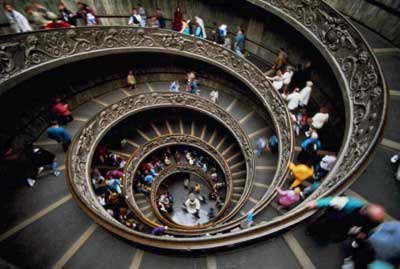|
|
|
Аlexey Stakhov, Anna Sluchenkova
Mathematical connections in nature,
science, and art
- ABSTRACT
В статье рассматривается концепция Музея Гармонии и Золотого Сечения как уникального естественнонаучного, исторического и художественного Музея, представляющего собой коллекцию всех созданий Природы, Науки и Искусства, основанных на Золотом Сечении http://www.goldenmuseum.com/
In the article we consider a concept of the Museum of Harmony and the Golden Section as unique history-nature-science-art museum, collection of the Nature, Science and Art works based on the Golden Section http://www.goldenmuseum.com/

- A CONCEPT OF HARMONY AND THE GOLDEN SECTION
Throughout the history people aspire to surround themselves with beautiful things. At some point the question arose: What is the basis of a Beauty? Ancient Greeks developed the science of aesthetics as a way to analyze a Beauty, believing that a Harmony is its basis. Beauty and Truth are interrelated: an artist searches for the Truth in the Beauty, and a scientist for the Beauty in the Truth.
Is it possible to compare the beauty of a sculpture, a temple, a picture, a symphony, a poem, or a nocturne? If a formula could be found, then the loveliness of a chamomile flower and a naked body could be measured and compared. The well-known Italian architect Leone Battista Alberti spoke about the Harmony as follows: «There is something greater, composed of combination and connection of three things (number, limitation and arrangement), something that lights up the face of beauty. And we called it Harmony, which is, doubtlessly, the source of some charm and beauty. You see assignment and purpose of Harmony in arranging the parts, generally speaking, different in their nature, by certain perfect ratio so that they meet one another creating beauty … It encompasses all human life, penetrates through the nature of things. Therefore everything that is made by Nature is measured by the law of Harmony. Also there is no greater care for the Nature than that of everything created by it to be perfect. It is impossible to achieve this without Harmony; therefore without it the greatest consent of the parts is disintegrated».
There are many well-known «formulas of beauty» such as certain geometrical shapes: square, circle, isosceles triangle, and pyramid. However, the most wide-spread criterion of beauty is one unique mathematical proportion called the Divine Proportion, Golden Section, Golden Number, or Golden Mean. The Golden Section and related to it Fibonacci numbers (1,1, 2, 3, 5, 8, 13, …) permeate the history of art. Examples of well known works, which exhibit this proportion, are Khufu's Pyramid of Egypt, the Parthenon in Athens, Greek sculpture, the «Mona Lisa» by Leonardo da Vinci, paintings by Rafael, Shishkin, and the modern Russian artist Konstantin Vasiljev, Chopin's etudes, music of Beethoven and Mozart, «Modulor» by Corbusier.
The Museum of Harmony and the Golden Section [1] contains a vast collection of information on the Golden Section in nature, science, and art. In virtual form, the Museum can be seen on the Web at http://www.goldenmuseum.com/. The main goal of the Museum is given in the introduction: «The 'Golden Proportion' is a mathematical concept and its analysis is first of all a problem of science. But it is a criterion of Harmony and Beauty, and this is already category of Art and Aesthetics. And our Museum, which is dedicated to analysis of this unique phenomenon, is doubtlessly, a scientific museum dedicated to the analysis of harmony and beauty from the mathematical point of view».
The Museum includes two main parts: cognitive and scientific. The former part aims to acquaint all people—students, teachers, engineers, specialists in various areas of science, artists, musicians, and representatives of all arts—with surprising discoveries of ancient science: the Golden Section and its various applications. The scientific part of the Museum aims to give information on modern scientific discoveries based on the Golden Section.
The Museum consists of the following halls:
(1) The Golden Section in History of Culture
(2) The Golden Section, Nature and Man
(3) The Golden Section in Art
(4) Mathematics of Harmony
(5) Fibonacci Computers
(6) Fibonaccization of Modern Science
(7) Harmonic Education
See full text of this article at PDF format (4128Kb).
Аlexey Stakhov, Anna Sluchenkova, Museum of Harmony and the Golden Section. Mathematical connections in nature, science, and art // «Академия Тринитаризма», М.,
|
|